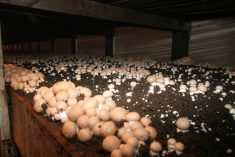Several sectors of agriculture have had to contend with competition from non-traditional products.
Dairy faces competition from oat and soy drinks.
In the meat case, beef and pork are up against substitutes made from vegetable protein and even lab-grown products.
Read Also

StatCan stands by its model-based crop forecast
Statistics Canada’s model-based production estimates are under scrutiny, but agency says it is confident in the results.
And now, fashionable leather faces a new product that comes not from cattle, hogs or even rattlesnakes.
It comes from mushrooms, or at least fungal mycelium.
I doubt the business of tanning and processing animal hides will disappear anytime soon, but there is a growing buzz about advances in harnessing mycelium, fungi’s fine root-like structure called hyphae, to make a range of products, including leather alternatives, but also building products, packaging and food.
Of course, faux or synthetic leather, sometimes called pleather, made from petroleum products, usually polyester coated with a plastic, has been used in clothing and upholstery for a long time.
It tends to be cheaper than the real thing and it addresses concerns from those who want a vegan lifestyle.
However, petroleum-based faux leather tends to be less durable than the real thing and some people are concerned about its environmental footprint because it comes from the fossil fuel industry.
These types of concerns are top of mind in the high end of the fashion industry.
So top brands such as Hermes, famous for its expensive purses, and PVH Corp., owner of Calvin Klein, are working with start-up companies harnessing mycelium to grow a product that they say is much like leather in look, strength, durability and performance.
In nature, fungi can have mycelium that are microscopic or incredibly large, such as the fungus called Armillaria ostoyae, or honey mushroom, in the Malheur National Forest in Oregon, whose lace-like hyphae are estimated to spread 2,200 acres and might weigh as much as 31,500 tonnes.
In the past couple of decades, inventors have seen the potential in mycelium to “grow” products that are more environmentally friendly than those made from plastic or livestock.
The companies in this sector are still small, considered start-ups with technological hurdles to overcome before they can become mainstream.
But they are making progress.
For example, a New York state company called Ecovative started out using mycelium to grow through agricultural waste such as hemp hurds, binding it together to create a foam-like product. This is done in a mould and can replace other moulded foam products such as styrofoam packaging.
Ecovative is among other biomaterial companies that are also making leather substitutes.
They select various fungi species for desirable traits in their mycelium to grow large sheets of 100 per cent mycelium foam-like material that is then cut and compressed into a leather-like material.
Each company has its own patented processes to get the closest they can to the look, feel, workability and durability of real leather.
And they are driving costs out of the process to make their products cheaper than tanned animal hides.
Unlike petroleum-based leather alternatives, this biomaterial is biodegradable.
The start-ups are working with big fashion companies that are dipping their toes into the biomaterial world.
Ecovative created a division for its leather products called Forager. It is working with Ecco Leather, a division of the Danish footware company Ecco, that has expertise in tanning to develop and commercialize products for shoes, clothing and accessories.
MycoWorks, with headquarters in California, is another mycelium biomaterial maker with a luxury product called Reishi that is finding its way into clothing, furniture and even tested as an interior door finish in a concept Cadillac car.
Mycelium is being experimented with in many other less glamorous fields.
A British start-up called Mykor with a pilot factory in Portugal is taking biomass residues from industries that would have been incinerated or discarded and putting them with mycelium to grow both rigid and loose-fill insulation for buildings
University researchers in several countries are studying ways to use mycelium to create alternatives to concrete, wall panels and other building components that are sound insulating and naturally fire resistant.
Getting back to Ecovative, it is also creating food — a bacon substitute called MyBacon.
It has spun off a company called MyForest Foods to commercialize it.
It takes slabs of mycelium, slices them up, soaks them in a brine of salt, sugar and a smoke flavour, and adds coconut oil to replicate the taste and mouth feel of bacon.
It is already in 1,200 grocery stores and has plans to expand to up to 5,000 by the end of the year and add a pulled pork product.
It has four farms growing the product, one in the United States, two in the Netherlands and one in Canada.
The Canadian operation is Whitecrest Mushrooms in Putnam, Ont., where a dedicated, state-of-the-art facility can grow three million pounds on less than an acre of land.
To contact D’Arce McMillan, email newsroom@producer.com.

















